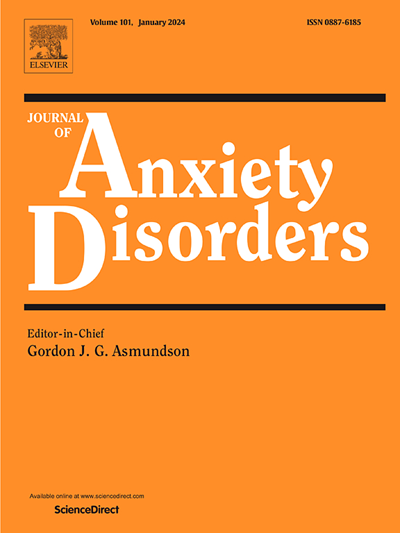Trajectories of grief-related psychopathology: A decade after the MH17 plane disaster
IF 4.5
2区 医学
Q1 PSYCHIATRY
引用次数: 0
Abstract
Violent losses increase the risk for prolonged grief disorder (PGD), posttraumatic stress disorder (PTSD), and major depressive disorder (MDD). Little is known about the course of grief-related psychopathology in the long term. Hence, we examined their latent trajectories, overlap, and predictors to enhance our understanding of differential long-term responses to violent loss. MH17-bereaved people (N = 299) completed annual self-report measures from one to nine years post-loss. Prolonged grief (PG), posttraumatic stress (PTS), and major depression (MD) symptom trajectories were identified using latent class growth modeling. Overlap in trajectory membership was examined using frequencies. Predictors of trajectory membership were examined using multinomial regression analyses. Four PG symptom trajectories emerged: low (41.0 %), moderate decreasing (34.2 %), high (13.5 %), and recovered (11.3 %). Four PTS symptom trajectories emerged: low (56.2 %), recovered (19.6 %), moderate increasing (17.6 %), and high (6.6 %). Four MD symptom trajectories emerged: low (55.7 %), moderate (19.6 %), moderate decreasing (15.1 %), and high (9.5 %). The findings indicate that if people report psychopathology, this often entails PGD by itself, and sometimes in combination with PTSD and MDD, yet rarely PTSD or MDD by itself. Around one in 20 people was assigned to all three high symptom trajectories. Different predictors were found across disorders. To conclude, most MH17-bereaved people reported low grief-related psychopathology, yet one in six reported high grief-related psychopathology levels (i.e., at least probable PGD, PTSD, or MDD) nearly a decade later. There is no indication of a delayed onset of grief-related psychopathology.
与悲伤相关的精神病理学轨迹:MH17空难十年后
暴力损失增加了长期悲伤障碍(PGD)、创伤后应激障碍(PTSD)和重度抑郁症(MDD)的风险。从长期来看,人们对悲伤相关的精神病理过程知之甚少。因此,我们研究了它们的潜在轨迹、重叠和预测因素,以增强我们对暴力损失的不同长期反应的理解。mh17遇难者(N = 299)在失联1 - 9年后完成了年度自我报告。使用潜在类别增长模型确定了长期悲伤(PG)、创伤后应激(PTS)和重度抑郁(MD)的症状轨迹。使用频率检查轨迹隶属度的重叠。运用多项回归分析检验轨迹隶属度的预测因子。出现了四种PG症状轨迹:低(41.0 %)、中度减轻(34.2% %)、高(13.5 %)和恢复(11.3 %)。出现了四种PTS症状轨迹:低(56.2% %)、恢复(19.6% %)、中度增加(17.6% %)和高(6.6% %)。出现了四种MD症状轨迹:低(55.7% %)、中度(19.6 %)、中度减轻(15.1 %)和高(9.5 %)。研究结果表明,如果人们报告精神病理,这通常伴随着PGD本身,有时会合并PTSD和MDD,但很少单独出现PTSD或MDD。大约每20人中就有一人被分配到所有三个高症状轨迹。在不同的疾病中发现了不同的预测因子。综上所述,大多数mh17丧亲者报告的与悲伤相关的精神病理程度较低,然而近十年后,六分之一的人报告了与悲伤相关的精神病理水平较高(即至少可能患有PGD、PTSD或MDD)。没有迹象表明与悲伤相关的精神病理延迟发作。
本文章由计算机程序翻译,如有差异,请以英文原文为准。
求助全文
约1分钟内获得全文
求助全文
来源期刊

Journal of Anxiety Disorders
Multiple-
CiteScore
16.60
自引率
2.90%
发文量
95
期刊介绍:
The Journal of Anxiety Disorders is an interdisciplinary journal that publishes research papers on all aspects of anxiety disorders for individuals of all age groups, including children, adolescents, adults, and the elderly. Manuscripts that focus on disorders previously classified as anxiety disorders such as obsessive-compulsive disorder and posttraumatic stress disorder, as well as the new category of illness anxiety disorder, are also within the scope of the journal. The research areas of focus include traditional, behavioral, cognitive, and biological assessment; diagnosis and classification; psychosocial and psychopharmacological treatment; genetics; epidemiology; and prevention. The journal welcomes theoretical and review articles that significantly contribute to current knowledge in the field. It is abstracted and indexed in various databases such as Elsevier, BIOBASE, PubMed/Medline, PsycINFO, BIOSIS Citation Index, BRS Data, Current Contents - Social & Behavioral Sciences, Pascal Francis, Scopus, and Google Scholar.
 求助内容:
求助内容: 应助结果提醒方式:
应助结果提醒方式:


